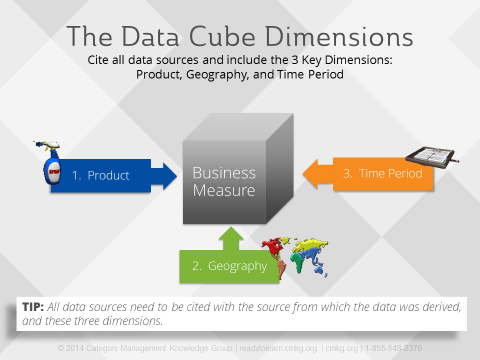Data is one of the biggest requirements in category management for moving toward a more strategic, fact-based organization.
Many organizations spend millions of dollars on data and sometimes even more money to mine the data through software and front-end reporting systems.
But organizations too often forget to train their organization on some of the most important things about data.
This is what can lead to misinterpretations and frustrations when using data.
Here are some of the key data sources used in category management:
- Retail point of sale (POS) or scanned sales data
- Syndicated data
- Consumer panel data
- Warehouse / shipment data
- Other data sources
Before you start understanding the different data sources available, you need to learn some of the basics when using data. Here are some ways to get started on understanding and using category management data:
- Download a great resource to understand data availability: Market Data Availability Grid
- Check out our accredited, online course on “Understanding and Using Data”
- View our “Understanding and Using Data” course preview
Looking for tips for more effective data insights? Here’s three …
The following tips will help you to draw better category management data insights —without knowing these things, your team may draw incorrect conclusions or lose credibility when using data.
1. Use Proper Data References.
Whenever you use or refer to data in a presentation, make sure you source the data appropriately, including the geography, time period, product, measure and data source (see the data cube below).
As a Retailer you should define the time period and geography standards for category reviews and business reviews so that there are consistent views of your data (and share these standards with your Vendor partners).
As a Vendor, don’t try to find the data that makes your brand look better—stay consistent with the most standard time periods and geographies most relevant for the business issue. Remember that negative trends or numbers can also represent a big opportunity.

2. Use Comparisons for Benchmarks and Relativity.
When reviewing results in a business review or category review, include relevant comparisons rather than sharing sets of numbers that have no meaning on their own or assuming “good” or “bad” based on norms. This will help to make your numbers come alive. For example,
| LESS MEANINGFUL | MORE MEANINGFUL |
| “Category X has a 90% penetration at Retailer A which is very high.” | “Retailer A’s penetration of 90% is behind Competitive Retailer B’s penetration of 92.5%. This represents an opportunity for Retailer A to increase penetration.” |
| “Category X is doing well at Retailer A, up 2% vs a year ago.” | Retailer A is losing market share in the category, despite growing at 2% last year. This means their competitors are growing in this category at a faster rate.” |
3. Don’t Just Rely on Others—Know Your Stuff!
Regardless of what level you’re at or your role, you should know how to read and interpret numbers—and in particular, those that affect your business or help you make more strategic decisions and recommendations.
Retailers, don’t be naive about the numbers and don’t rely on your Vendors to tell you what’s happening in your categories and business.
You should be well-versed in your categories and understand all of the numbers that are presented to you. Lead the collaborative discussions and make the appropriate decisions for your categories.
Vendors, start looking at different data sources and beyond your brand results to discover category opportunities for both you and your Retailers. This is a necessary step if you want to move to a more collaborative business approach with your partners.
Benefits of Strategically Understanding and Using Data
Business Wins:
- Make more fact-based, strategic insights to grow your business and your collaborative partner’s business
- Create new strategic solutions and uncover new opportunities for your business
- Add value to your team, organization and/or customers
- Make better decisions than the competition, focused on Shopper
Personal Wins:
- Lead your team
- Stand out among your peers
- Get that next promotion
- Land that new job
By training your team (or preferably your whole organization) on proper data usage, data sources available and how and when to use different data sources, you will take the first step in moving your organization to a more fact-based, strategic organization (and improve your data return on investment!).
Don’t assume that everyone knows or understands these important foundations—skipping this step may result in limited results. Once you create this level of data understanding, it’s time to start analyzing data—moving data to insights!
Looking for more data insights? Category Management Knowledge Group can help you to move your team to the next level through custom category management training programs.
Check out our accredited course on “Understanding and Using Data”, which shares more tips and walks through the key category management data sources and how you can maximize their use. It also gives an 8-step process to analytic success so you can plan your bigger analysis projects before you start.
|
$125 USD 30-day Access Hands-On Downloadable Reference Guide Knowledge Checks Course Test |



